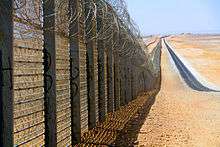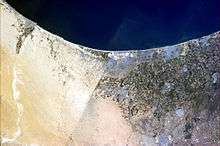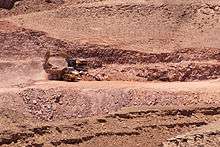Egypt–Israel barrier
The Egypt–Israel barrier (or Egypt–Israel border fence; Project name: Hourglass, Hebrew: שְׁעוֹן הַחוֹל, Sha'on HaḤol, lit. “sand clock”) refers to a border barrier built by Israel along its border with Egypt. It was originally an attempt to curb the influx of illegal migrants from African countries.[2] Construction was approved on 12 January 2010[3] and began on 22 November 2010.[4][5] However, following increased insurgent movement across the southern border in 2011 in wake of the crisis in Egypt, Israel upgraded the steel barrier project to include cameras, radar, and motion detectors. In January 2013, construction of the barrier was completed in its main section.[6] The final section of the fence was completed in December 2013.[7]


A number of countries, including the United States and India, have sent delegations to Israel to study border security and the various technologies used by the IDF to secure Israel's borders, including the Israel–Egypt border. Some of these countries may implement these technologies as part of their own border fences.
About 245 kilometres (152 mi) long,[8][9][10] the fence from Rafah to Eilat took three years to construct, at an estimated cost of NIS1.6 billion ($450 million), making it one of the largest projects in Israel's history.[7]
Background
An old rusty low fence swamped by shifting sand dunes has existed in the Negev desert along Israel's Sinai Peninsula border with Egypt, mainly serving as a marker between the two countries. Smuggling of cigarettes and drugs often carried on camels by Bedouins whose tribal lands straddle the border, has been a long-term problem. In December 2005 armed infiltrations into Israel along the porous border led to calls for the construction of a security fence.[2] The Israeli government decided in the late 2000s to build the barrier.
Purpose
The barrier was originally planned in response to high levels of illegal migrants, mainly from Eritrea and Sudan, who successfully entered Israel across the border, usually smuggled by Bedouin traffickers. Tens of thousands of people attempted to cross from Egypt's Sinai peninsula into Israel every year, predominantly economic migrants. During Hosni Mubarak's regime, Egyptian border guards sometimes shot African migrants trying to enter Israel illegally.[11][12] Israeli Prime Minister Benjamin Netanyahu stated that the barrier is meant to "secure Israel's Jewish and democratic character."[13] The 2011 Egyptian revolution, the demise of Mubarak's regime, increased lawlessness and rising insurgency in the Sinai, as well as the 2011 southern Israel cross-border attacks led to the project's upgrading with surveillance equipment and its timetable for completion being expedited.[14]
Construction

The fence has two layers of fencing, one with barbed wire.[15] The structure includes the installation of advanced surveillance equipment. Eventually the whole border will be sealed. The estimated cost of the project is NIS1.6 billion ($450 million).
In March 2012, nearly 105 km of fence had been built by 30 contractors working concurrently and building several hundred meters of the fence every day. The goal was to finish the remaining 135 km, including those running through the mountainous area of Sinai, in 2012.[16] Construction of the main section 230 km was completed in January 2013.[17][18] The project was completed in December 2013.[7]
Reaction
Egypt has said it did not object to the fence's construction, so long as it was built on Israeli soil.[13]
Effects on illegal entry
While 9,570 citizens of various African countries entered Israel illegally in the first half of 2012, only 34 did the same in the first six months of 2013, after construction of the main section of the barrier was completed.[19][20][21] After the entire fence was completed, the number of migrant crossings had dropped to 16 in 2016.[22]
Interest by other countries
A number of countries have sent delegations to Israel to study border security and the various technologies used by the IDF to secure Israel's borders, including the Israel–Egypt border. For example, a delegation from India arrived in August 2012 to study these technologies that are used to secure the borders with the Gaza Strip, the West Bank, and Egypt, which may be implemented as part of India’s own fence with Pakistan and Bangladesh. The interest in Israeli border security increased since the construction of the fence along the Israel–Egypt border. The United States, which occasionally adds to a partial barrier along its border with Mexico, is also following Israel’s decisions on border security closely.[23]
See also
![]()
References
- Otterman, J.; Waisel, Y.; Rosenberg, E. (March 1975). "Western Negev and Sinai ecosystems: Comparative study of vegetation, albedo, and temperatures". Agro-Ecosystems. 2 (1): 47–59. doi:10.1016/0304-3746(75)90005-0.
- Butcher, Tim. Sharon presses for fence across Sinai, Daily Telegraph, December 07, 2005.
- "11 Jan, 2010; from google (Israel–Egypt barrier construction began) result 8".
- "November 22, 2010; from google (Israel–Egypt barrier construction began) result 10".
- "Nov 21, 2010; from google (Israel–Egypt barrier construction began) result 10".
- Israel completes most of Egypt border fence, Los Angeles Times. January 2, 2013
- Israel Completes 245 Mile, NIS 1.6 Billion Security Fence Along Sinai Border with Egypt Algemeiner, DECEMBER 4, 2013 2:58 PM
- "Israel finishes building border fence with Egypt". Egypt Independent. 2013-12-04. Retrieved 2017-01-29.
- Harriet Sherwood (2012-12-31). "Israeli fence construction cuts off migration from Egypt". The Guardian. Retrieved 2017-01-29.
- Dana Nasi (2013-12-04). "The border fence between Israel and the Sinai has been completed". JOL. Retrieved 2017-01-29.
- Migrants killed on Egypt's border, BBC, March 27, 2008
- Sudanese killed on Egypt's border, BBC, August 19, 2008.
- Israel to construct barrier along Egyptian border , BBC, January 11, 2010.
- Joel Greenberg (2011-12-02). "On Israel's uneasy border with Egypt, a fence rises". Washington Post. Retrieved 2012-03-25.
- Israel to build surveillance fence along Egyptian border, The Guardian, January 11, 2010.
- Barak Ravid (2012-03-12). "Netanyahu is sitting on the fence, and loving it". Haaretz. Retrieved 2012-03-28.
- "Israel completes bulk of Egypt border of fence". Reuters. January 2, 2013. Retrieved January 2, 2013.
- PM tours South, heralds completion of border fence, Jerusalem Post. January 2, 2013
- New Data Shows 99% Drop in Illegal Entry, Arutz Sheva. July 2, 2013
- 99.6% Drop in the Number of Infiltrators Entering Israel Due to Government Action Archived 2013-09-30 at the Wayback Machine, Israeli Prime Minister official website. July 1, 2013
- Israel to trade arms for migrants with African countries, Ynetnews.com. July 9, 2013
- ISRAEL COMPLETES HEIGHTENED EGYPT BORDER FENCE
- Katz, Yaakov (July 29, 2012). "India, US looking to learn from Israel's border security". The Jerusalem Post. Retrieved July 29, 2012.